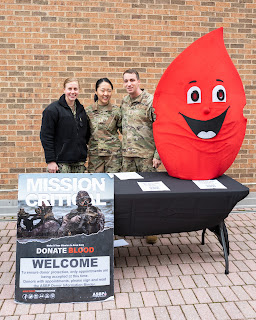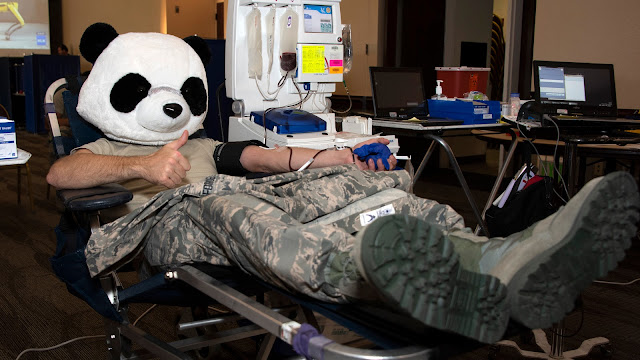USU Student’s Dedication Leads to Mission Critical, Lifesaving Blood Drives
By Hadiyah Brendel
Air Force 2nd Lt. Adam Stainiger knows firsthand the life-extending properties that blood provides. In August 2014, Stainiger’s mother, Jean, was diagnosed with Stage 4 stomach cancer, requiring multiple transfusions. Because of her experiences, Stainiger has dedicated his efforts to helping others.
Monthly blood drives at Uniformed Services University (USU) between September 2021 and September 2022 collected more than 200 units of mission-critical blood donations. These blood drives, coordinated by Stainiger, a second-year USU medical student, impacted nearly 800 service members, their beneficiaries, retirees, and veterans. Blood donations and blood products, such as whole blood, red blood cells, platelets, plasma and transfusion elements provide lifesaving treatment.
 |
| Stainiger's blood donation booth, alongside ENS Amy Pearson (left) and 2nd Lt. Elizabeth Kwon (middle). (Photo courtesy of 2nd Lt. Adam Stainiger) |
In October 2015, Stainiger began training as a 4TOX1, a medical laboratory technician, at Fort Sam Houston. Over the Thanksgiving break, Stainiger took leave to spend time with his family. At home in Minnesota, he accompanied his mother to one of her blood transfusion appointments. Stainiger witnessed the effects the blood transfusion provided his mother, extending the time he and his family shared with her.
“That’s why I’m so dedicated,” Stainiger says, “because every unit does make a difference to all of the families who get those transfusions.” His mother lost her battle with cancer in February 2016.
Stainiger’s desire to be more involved in the military healthcare system was initiated working in the microbiology department at David Grant Medical Center (DGMC) at Travis Air Force Base. Part of his role in the lab included working with Infectious Disease physicians. They processed samples from patients with a range of ailments such as septicemia from multi-drug resistant infections.
"All we get is a name and DOB [date of birth] for our samples, complete the ordered tests and report out the results," he explains. Often curious about the patient outcomes, Stainiger reflects that behind each sample’s label “is a patient who needs our help.”
He took his initial step toward making a larger impact by getting involved with the blood drives on Travis Air Force Base. Since Stainiger volunteered with other organizations, his involvement with the blood drive began slowly. A civilian company that supplied blood products for DGMC already had a mobile unit standpoint on base, and once Stainiger became involved as an assistant blood drive coordinator, they established an onsite location. The new location allowed 120 units per drive to be collected, significantly exceeding the initial 10 to 15 units the mobile unit received. Stainiger dedicated more than 400 hours of service during his three years providing support at Travis Air Force Base. And overall, he helped achieve a total collection of 784 units of blood, which potentially impacted the lives of up to 2,352 military members and their beneficiaries.
After three years working in the lab, Stainiger thought about commissioning as an officer within the medical laboratory itself. While researching the process, he found information for USU’s Enlisted to Medical Degree Preparatory Program, or EMDP2. The program offers enlisted personnel with a bachelor’s degree a pathway to commission as a military physician. Stainiger decided to apply.
“After my interactions with our ID doctors and the limited contact we have in the lab,” he says, “I knew I wanted to have more time with our patients. I wanted to pursue becoming a physician to have a more personal impact on the patients we care for.”
Stainiger and his wife moved to Virginia after his acceptance into the EMDP2 program in June 2019.
“I have really strong support, especially from my wife Megan,” he says. Even as she pursued a degree in teaching, “she’s always been there for me.”
Nearly two years later, as Stainiger finished his time in the program, he applied to USU’s School of Medicine and awaited a response. Of his time in the EMDP2 program, Stainiger expresses that “words cannot suffice for how grateful I am for the program. Without it, I most likely would not be in medical school about to start rotations.”
Stainiger was selected to join the USU School of Medicine’s Class of 2025 and commissioned as an Air Force second lieutenant in June 2021. Once at USU, Stainiger realized the potential impact of hosting a blood drive within the university’s large community of students and personnel. "After an amazing response from our students and the USU community for the first couple drives, I decided to make it into a monthly event.”
Stainiger credits the donors for the drive’s continued success, saying, “Without our donors, there is no blood drive. So they are truly the ones who deserve all the recognition.” Some donors are even repeat participants, donating every eight weeks as guidelines allow. Stainiger set a 200-unit goal for 2022. By the end of December, donors contributed 207 units of blood, reaching that goal. In total, the 67 units collected in 2021 and the 207 units in 2022 will result in significant savings to the DoD and military health care system. The drive will impact up to 822 lives of service members and their families.
 |
| Just one pint of donated blood can help save as many as three people's lives. (U.S. Air Force photo by Heide Couch) |
In addition to coordinating the blood drives, Stainiger also serves as a handler for USU’s facility dogs. He worked with Shetland, who is now retired, and currently handles Grover. Stainiger says Grover is “an outlet for a lot of people” on campus, “for moral and community support” which is why he enjoys volunteering to walk Grover. When asked how he finds balance between volunteering, his school work, and personal life, Stainiger admits it’s been difficult. “Balance has been a constant struggle throughout medical school between spending time with my wife, academics, blood drives, and other extracurriculars. There have been some ups and downs over the last 18 months for various reasons, but I have been able to push through some of those hard times with support from my family, classmates, and the faculty at USU.”
As Stainiger prepares to leave for rotations, the next step towards becoming a physician, he is grateful for the continued support he’s found at USU. Stepping up to the leadership role once he leaves are Navy Ensign Amy Pearson and Army 2nd Lt. Elizabeth Kwon. Stainiger also credits Army Col. Patrick Donahue, USU’s Brigade Commander, as being “super helpful and supportive for the blood drives [and] for me as well. Every eight weeks he asks me if he can donate. He’s been a really strong support for the program since it started last year.”
Stainiger says he looks forward to using what he’s learned so far to make a personal impact on patient’s lives, as well as seeing “the whole-person aspect of patient care.” And though his time coordinating the blood drives is ending, Stainiger says “It makes me feel good personally because I know it’s going to save, literally save people’s lives and extend the time with their families.”







